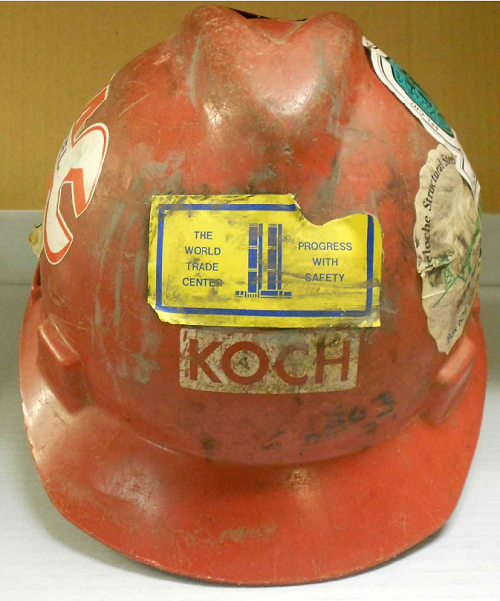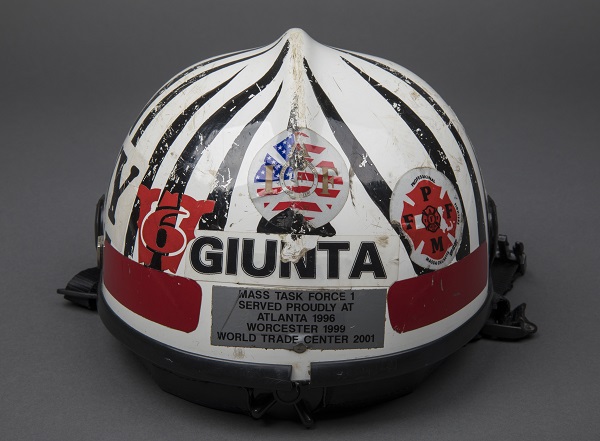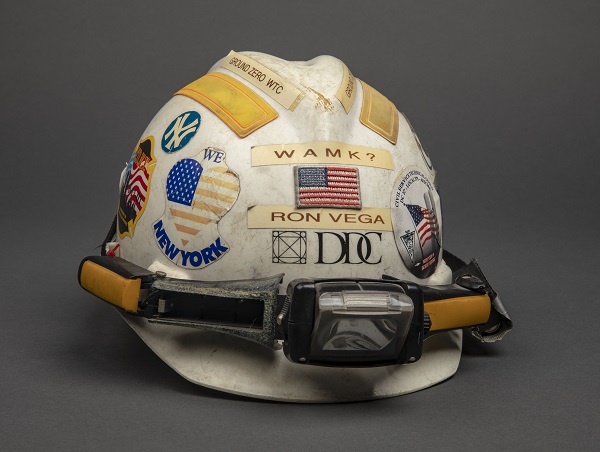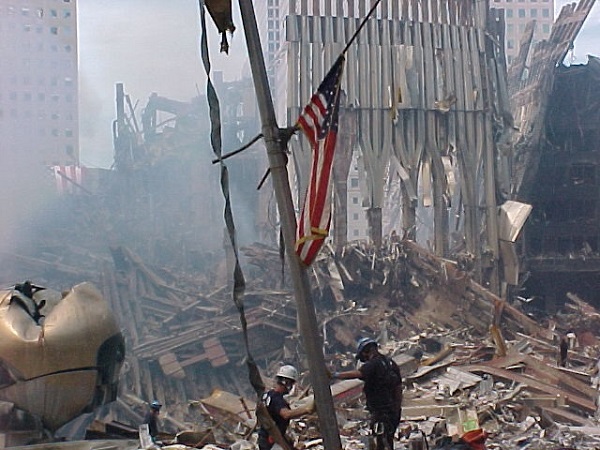Make a donation to the museum
Hardhats of the Rescue and Recovery Effort
Hardhats of the Rescue and Recovery Effort

Ubiquitous in demolition and construction sites, hardhats are used both for safety and for identification purposes. The 9/11 Memorial Museum collection is home to several hardhats used during the rescue and recovery effort that followed the Sept. 11 attacks. In many cases, these hardhats served as vehicles of expression and badges of honor. Today we highlight four hardhats that hold special significance.

David Rice
David Rice, a member of the Mohawk Kahnawake, was barely 19 years old when he became a member of the Local 40 ironworkers’ union, following in the footsteps of his extended family and prior generations of Mohawk “sky walkers,” or ironworkers employed in the construction of skyscrapers.
Rice was among the ironworkers who helped build the World Trade Center. He saved the hardhat he wore during the construction of the North Tower and on some later jobs before donating it to the Museum. Its adhesive decals attest to his long career as an ironworker.
The stories of Mohawk ironworkers will be highlighted in an upcoming exhibition at the 9/11 Memorial Museum in fall 2018.

Gerry Giunta
Gerry Giunta is a career firefighter and long-time member of FEMA’s Urban Search and Rescue program. Upon completing his Urban Search and Rescue training in the early 1990s, Giunta had to purchase a standard rescue helmet. Considering the white helmet “too plain,” he decided to personalize it by painting black stripes on its surface. Ignoring comments and a reprimand that it was unprofessional, he found that its unusual surface decoration made it easy for others to find him at disaster scenes.
On Sept. 11, 2001, Giunta, who is based in Salem, Mass., responded to lower Manhattan with Massachusetts Task Force 1. Upon arrival at the World Trade Center site, he was put in command of his team for the day shift and coordinated their service from a base of operations on Church Street. The black-striped helmet he wore enabled his own team members, counterparts at the FDNY and FEMA photographer Andrea Booher, among others, to readily identify him.
Some years later, Giunta returned to New York to help transport a piece of World Trade Center steel to Beverly, Mass., for that town’s 9/11 Memorial. He wore his striped helmet during that mission as well. In May 2016, Giunta attended the opening of Hope at Ground Zero and brought the helmet with him as a gift to the Museum.
Richard Stallings
Assigned to the FBI’s Safe Streets Task Force in Washington, D.C., Special Agent Richard Stallings was wrapping up an arrest the morning of Sept. 11, 2001, when he heard that a plane had struck the World Trade Center. Shortly thereafter, he received a transmission over his FBI radio that directed all FBI personnel on the streets to deploy to the Pentagon in response to reports of a plane crash and smoke.
Arriving on the scene after a half-hour’s drive, Stallings saw smoke, flames and plane parts strewn across the lawn. After putting on his FBI raid jacket and work gloves, Stallings focused on the search for survivors. He remained at the Pentagon until around midnight, aiding in the rescue, retrieving airplane parts and other material that might be considered evidence, and performing other functions as needed.
Stallings was assigned to work with FEMA Urban Search & Rescue teams and the military through to late October 2001 to search damaged sections of the Pentagon, recover the bodies of those who had been killed and retrieve documents. Within a few days on site, he was issued an FBI hard hat and a photo ID card giving him clearance to search all areas of the Pentagon.
For much of his service at the crash site, Stallings supervised a team of FBI personnel assigned to the recovery operation. Aware of the hazardous conditions, he was concerned about the possibility of his team becoming separated or injured. He adopted a system devised by a colleague to keep track of team members, using name tags that could be attached to a Velcro pad on a hardhat. He attached the name tag for each team member to his hardhat at the start of a mission and returned the tag to each at the end. Any remaining name tags would indicate that a member had become separated and needed to be accounted for and reunited with the others.

Ronaldo Vega
Trained as an architect, Ronaldo Vega was employed by the New York City Department of Design & Construction (DDC) when the World Trade Center was attacked on Sept. 11, 2001. As soon as he obtained authorization, Vega joined other DDC staff voluntarily suspending their ordinary assigned duties to serve at Ground Zero. Vega began work there on Sept. 18, 2001, and remained on site for the duration of the recovery period, working his final shift on July 12, 2002.
Vega usually worked the night shift (approximately 3:00 p.m. to 1:00 a.m.), with responsibility for the AMEC quadrant of the site. Among the responsibilities at Ground Zero most meaningful to Vega were the respectful recovery of human remains that affected all of his actions and the special nature of working at the site on Christmas Day in 2001.
Vega’s hardhat was issued by DDC and worn throughout his time at Ground Zero. Like many who worked there, Vega occasionally attached to the hardhat an adhesive sticker relating to his patriotism, union affiliation and other related matters. The hardhat also bears traces of signatures and messages written by celebrities who played a supportive role at Ground Zero; those markings have mostly faded from the hardhat.
By 9/11 Memorial Staff
Previous Post
Remembering the Life and Service of Recovery Worker Paul W. Reedy Sr.

Paul W. Reedy Sr. (1945–2015) was born and raised in Mount Vernon, N.Y. He began his 17-year career with the New York City Department of Design and Construction (DDC) as a construction agent and worked his way up to a director’s position before retiring in 2006.
Next Post
Photo Archive Shows Dedication of Rescue and Recovery Workers

A family celebration in honor of his 43rd birthday on the evening of Sept. 10, 2001, led Donald Anderson to call his supervisor the following morning to request the day off.